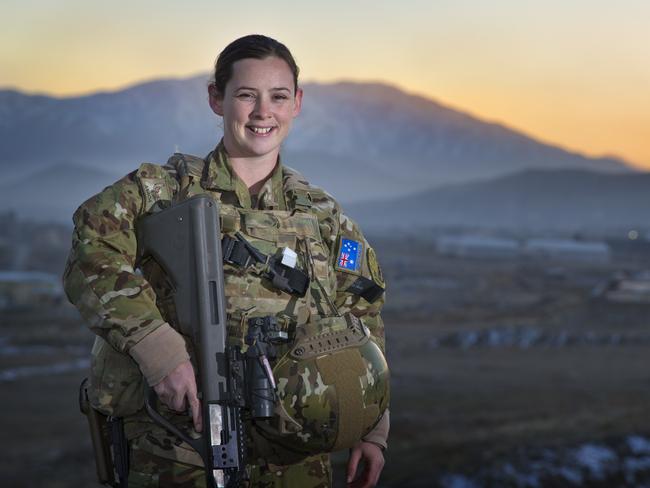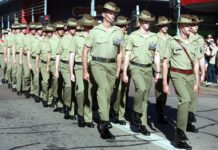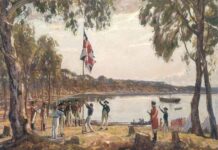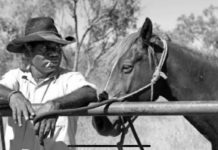 I wanted a way to highlight the problem of the Slippery Slope, the process by which things move in only one direction. How each thing builds upon the next thing and leads further and further until we are left wondering how did things get this bad.
I wanted a way to highlight the problem of the Slippery Slope, the process by which things move in only one direction. How each thing builds upon the next thing and leads further and further until we are left wondering how did things get this bad.
In Western armies women did not serve in any official capacity until the 1850’s. Women were however present with nearly every army, they were a good portion of what were called ‘camp followers’. Camp followers were all those people who followed the army camp and included wives and children of the soldiers, girlfriends, prostitutes and all manner of men and women who thought that they could make money off either the army or the soldiers. While they did not wear uniforms, were not paid by the army, did not fight and were rarely subject to military discipline. Women performed valuable service for the army, they took care of the sick and wounded, they found supplies for the army and they cooked. laundered and cleaned.
During the 1800’s that began to change as armies decided that they needed their own permanent supply systems, complete with all of the facilities that it would require in war. Women were no longer allowed to follow the armies. But at the same time that this was happening another thing was allowing women into the army. Before the 1850’s most armies’ medical care was very rudimentary. Each regiment had its own doctor and he had some staff and that was about it. During the Crimean War, the British army decided to send female nurses to treat the wounded. This was not a popular decision as female nurses had a very bad reputation, but one women was to change that, Florence Nightingale. Her efforts helped save many of the sick and wounded British soldiers during the war.
The American Civil War saw more female nurses serve and while women were kept as far from the fighting as possible it now became accepted that women had a small place within armies. In WWI women’s roles increased as the armies grew to an enormous size. The demand for manpower grew and grew, men were needed in the armed forces, in industry and in agriculture. The demand was so great that women were sought to fill any role that they could do so that a man would become available for military service. By 1917 that included Auxiliary military units, who wore uniforms, were paid by the government and were subject to military discipline, but they were not strictly part of the armed forces. They carried out roles far from the front and many were in what were regarded as women’s jobs, such as Telephonists. Although they also did jobs that were regarded as men’s work but which women could physically do, like clerking and other office based jobs. Just to give an example of how these positions were regarded, women who joined the US military were not regarded as soldiers, were not given medals and did not get pension rights until 1977. At the end of the war all of these units were disbanded as a wartime necessity. But it was a further move on the slippery slope.
Even before WWII began new women’s services were created, and like before they were to take over jobs so that men could be made available, not just for military service, but for combat. Because unlike in WWI the roles that women performed were greatly expanded, they were still to be kept away from combat, but now they did many technical tasks, mechanic, drivers, flying aircraft between North America and Britain, within Britain flying newly built aircraft from the factories to military airfields. Each country had its own way of doing things.
In Germany women’s services were created, even though women were supposed to be wives and mothers only.
In Britain women served in mixed sex Anti-Aircraft batteries in semi-combat roles, men operated the guns, but women did the range finding and other tasks within the unit. In 1943 as the manpower shortage bit deep, women were conscripted for the first time in history. Unmarried women without children were liable for call up. Unlike men, women who were called up had a choice, they could serve in the Women’s Land Army, in approved industrial jobs or in the women’s services. Of those who served in the women’s services very few served outside of Britain and while they were subject to military discipline, they were not treated as harshly as men were. If a woman decided that she had had enough and wanted to go home, officially she was not allowed to, unofficially if she left they simply discharged her. If a man tried that it he would find himself in the infamous ‘Glasshouse’, the British army’s military prison.
The most interesting of women’s service was in the Soviet army. At the start of the war there were no women in the Soviet army. But women lobbied to serve just as they had in other countries during WWII. The Soviets had plans to create over 50 Brigades of women, that’s roughly 150,000 women but in the end they didn’t even create one. They did however create 3 air regiments that were all female and they were combat units. Two were equipped with very modern aircraft, the third was given obsolete biplanes. These aircraft flew at night as they would have been destroyed if they had flown during the day. They would turn off their engines and glide so that they could attack ground targets by surprise and then turn them back on after they had dropped their bombs. The Germans called them the Night Witches as it sounded like a witch’s cackle when they turned their engines back on.
Most women served as first aiders, clerks and signal personnel and it was common for women to serve in otherwise all male units as specialists. Although the most famous Soviet soldiers were snipers, the number of these women was small, a few hundred. They received a great deal of attention both during and after the war, but it is interesting that as the war went on there is less and less information about them.
The other combat task that women did was in the last year or so of the war to serve as drivers of the T-34 tanks. The driver’s compartment was tiny and short men were the only ones who could serve in that role. But as the war went on there were less and less of these men, so women were called upon to fill that role. Again it is interesting that it is such a very specific role, women, at least officially, did no service in other tanks or in other roles within the T-34. At the end of the war women were discharged from the Soviet army and except for medical roles women did not serve during the Cold War.
I would like to tell you two small stories from Australia. In 1944 Australia’s Prime Minister had a meeting with an Australian General, after the meeting he walked the General to his car. The driver got out of the car and opened the door for the General, the Prime Minister was shocked and exclaimed ‘But she’s a women!’ Traditionally men open doors for women, women don’t open doors for men. The General replied ‘No Prime Minister she’s a soldier!’
In 1945 just after the war in the Pacific had ended the head of the Australian Army Nursing Service decided that she would fly and meet the Australian nurses who had been prisoners of the Japanese. She was shocked at how badly the POW nurses looked after their captivity. However they were also shocked at the appearance of the head nurse, she was wearing pants. Before the war respectable women didn’t wear pants, men wore pants and women wore skirts or dresses. More motion on that slippery slope.
Unlike the Soviets, the West’s military leaders really liked the women’s services. Women who volunteered for military service were generally highly educated, intelligent with low levels of ill discipline. They were generally middle class, whereas most military personnel were working class. Here was a segment of the population that served in wartime but not in peacetime and if they were female instead of male that had its problems but it also had its advantages. The military pushed hard to retain the women’s services and they won. Women continued to serve during the Cold War. During WWII the vast majority of women did not serve outside of their own country. But after the war that changed, women now served overseas just as male personnel did. Another move on the slippery slope.
At many memorial services today you will often hear something along the lines of ‘our men and women’ who served or died and it gives off a very wrong impression. Now I do not want to give the impression that a woman dying in war is not worth remembrance, it is, but the numbers should also be kept in perspective.
In Vietnam around 2,500,000 Americans served and 58,000 died, of those 11,000 who served were women and 8 of them died, nearly 90% of the women served as nurses. A further 61 American women, all civilians, died in Vietnam, 38 of them in a plane crash in 1975 during Operation Babylift.
520 Australians died in the Vietnam War, 1 of them was female, she was diagnosed with leukaemia while serving as a nurse in Vietnam, she died in Sydney, Australia. I should say that if she had been a man his name would also be included. I only want to put this into perspective.
But just as things were happening in Vietnam things were happening outside of Vietnam. In this case Feminism, which said that anything a man can do women should be able to do as well. So from the 1970’s there grew a push for the roles that women did within the military to be expanded and for the end of the women’s services. Today there are no women’s services, they have all been disbanded and women reassigned to army units. At that time they were still forbidden from serving in combat, although in most countries women are now allowed to serve in combat units. But rarely do.
In Iraq, Afghanistan, Kuwait and Syria between 2001- 2021 152 American women died. below are those who died in 2009.
Afghanistan
- Sgt. Simone Robinson, 21, IED attack in Kabul on Feb. 28, single mother of two year-old daughter, Mar. 1, 2009.
- Navy Lt. Florence B. Choe, 35, killed by Afghan soldier while running at Camp Shaheen, Mazar-e-Sharif, 3 year-old daughter, March 27, 2009.
- Air Force Lt. Roslyn L. Schulte, 25, IED hit on vehicle near Kabul, May 20, 2009.
- Air Force Senior Airman Ashton L.M. Goodman, 21, IED hit on vehicle near Bagram AFB, May 26, 2009.
- Staff Sgt. Tara J. Smith, 33, non-combat related incident under investigation, mother of two boys, 8 and 6, August 4, 2009.
- Sgt. Eduviges G. Wolf, 24, RPG attack on vehicle, wife and mother of two girls, ages 3 and 1, October 22, 2009.
Iraq
- Spc. Jessica Y. Sarandrea, 22, mortar fire on forward operating base near Mosul, Mar. 3, 2009
- Staff Sgt. Army C. Tirador, 29, non-combat incident near Kirkush, Nov. 4, 2009.
- Pfc. Cwislyn K. Walter, 19, non-combat related, near Kuwait City, Feb. 19, 2009.
Mother of two year old daughter, 3 year old daughter, mother of two boys, 8 and 6, wife and mother of two girls, ages 3 and 1. These were not women killed in attacks on their homeland, these were women who were deployed into harm’s way.
This is where the slippery slope has taken us and we are not off the slippery slope. The slope is still here and it is still slippery and it will lead us on to further horrors. Horrors which our rulers call progress.
Originally published at Upon Hope. You can find Mark’s Subscribestar here.









